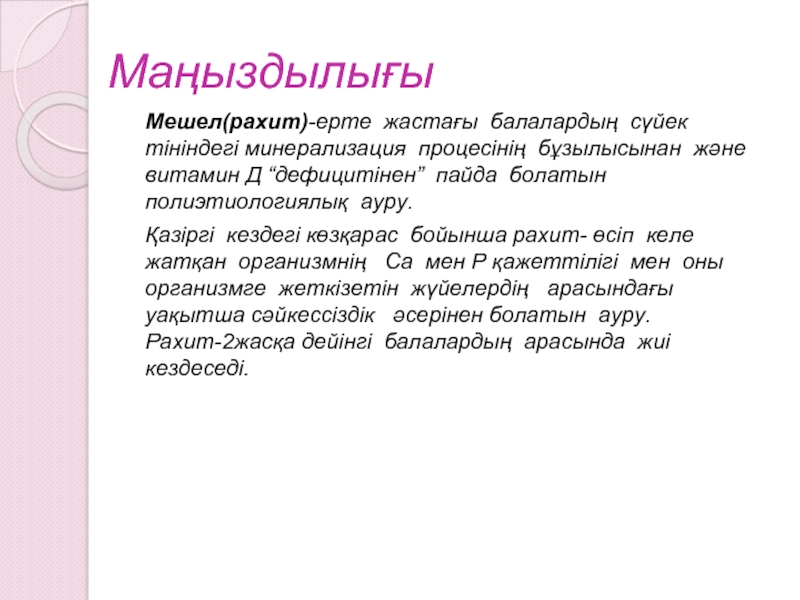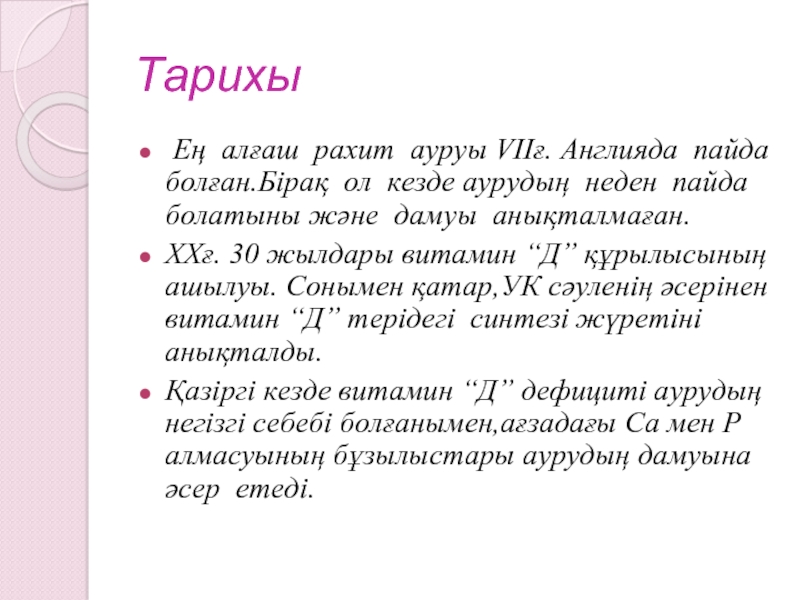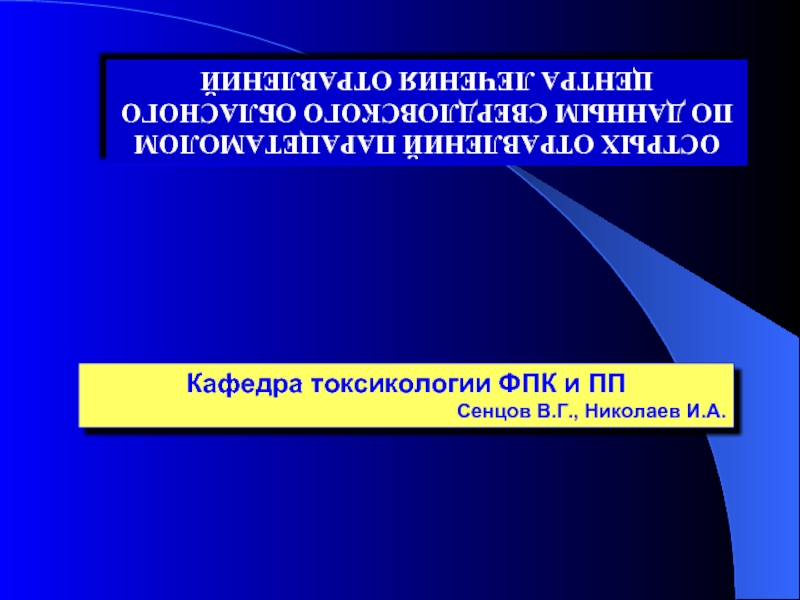- Главная
- Разное
- Дизайн
- Бизнес и предпринимательство
- Аналитика
- Образование
- Развлечения
- Красота и здоровье
- Финансы
- Государство
- Путешествия
- Спорт
- Недвижимость
- Армия
- Графика
- Культурология
- Еда и кулинария
- Лингвистика
- Английский язык
- Астрономия
- Алгебра
- Биология
- География
- Детские презентации
- Информатика
- История
- Литература
- Маркетинг
- Математика
- Медицина
- Менеджмент
- Музыка
- МХК
- Немецкий язык
- ОБЖ
- Обществознание
- Окружающий мир
- Педагогика
- Русский язык
- Технология
- Физика
- Философия
- Химия
- Шаблоны, картинки для презентаций
- Экология
- Экономика
- Юриспруденция
Рахитпен (мешел) ауыратын балаларда Д витаминінің әсері презентация
Содержание
- 1. Рахитпен (мешел) ауыратын балаларда Д витаминінің әсері
- 2. Маңыздылығы Мешел(рахит)-ерте жастағы балалардың сүйек
- 3. Тарихы Ең алғаш рахит ауруы VIIғ.
- 4. Мақсаты Рахитпен ауыратын балаларда Д витаминінің эффективтілігін анықтау
- 5. Тапсырма -Әдеби шолу жасау -Рахитпен ауыратын
- 6. Сұрақ: Рахитпен ауыратын балаларда сүйек жүйесінің деформация
- 7. Р- рахитпен ауыратын балалар І- Са+
- 8. Зерттеу дизайны: РБЗ, екі жақты Таңдау:
- 9. Этикалық аспектілер -
- 10. OBJECTIVE: The objective
- 11. СҰРАҚ: Д витаминiн кабылдаған жүктi әйелдер Кальций
- 12. Зерттеу дизайны: Рандомизирленген бақыланатын зерттеу(ашық түрі) Таңдауы:қарапайым-кездейсоқтық.
- 13. Пайдаланылған Әдебиеттер: http://www.ncbi.nlm.nih.gov/pubmed/ . Salzer J, Hallmans G, Nystrom M, Stenlund H, Wadell G, Sundstrom P. Vitamin D as a
- 14. Назарларыңызға рахмет!
Слайд 1Батыс Қазақстан Мемлекеттік Медицина Университеті
Тақырыбы: Рахитпен(мешел) ауыратын балаларда Д витаминінің әсері
Орындаған: Багитова Назгуль
Тексерген: Қошмағанбетова Г.К
Ақтөбе 2017ж
Слайд 2 Маңыздылығы
Мешел(рахит)-ерте жастағы балалардың сүйек тініндегі минерализация процесінің бұзылысынан және
витамин Д “дефицитінен” пайда болатын полиэтиологиялық ауру.
Қазіргі кездегі көзқарас бойынша рахит- өсіп келе жатқан организмнің Са мен Р қажеттілігі мен оны организмге жеткізетін жүйелердің арасындағы уақытша сәйкессіздік әсерінен болатын ауру. Рахит-2жасқа дейінгі балалардың арасында жиі кездеседі.
Қазіргі кездегі көзқарас бойынша рахит- өсіп келе жатқан организмнің Са мен Р қажеттілігі мен оны организмге жеткізетін жүйелердің арасындағы уақытша сәйкессіздік әсерінен болатын ауру. Рахит-2жасқа дейінгі балалардың арасында жиі кездеседі.
Слайд 3Тарихы
Ең алғаш рахит ауруы VIIғ. Англияда пайда болған.Бірақ ол кезде
аурудың неден пайда болатыны және дамуы анықталмаған.
XXғ. 30 жылдары витамин “Д” құрылысының ашылуы. Сонымен қатар,УК сәуленің әсерінен витамин “Д” терідегі синтезі жүретіні анықталды.
Қазіргі кезде витамин “Д” дефициті аурудың негізгі себебі болғанымен,ағзадағы Са мен Р алмасуының бұзылыстары аурудың дамуына әсер етеді.
XXғ. 30 жылдары витамин “Д” құрылысының ашылуы. Сонымен қатар,УК сәуленің әсерінен витамин “Д” терідегі синтезі жүретіні анықталды.
Қазіргі кезде витамин “Д” дефициті аурудың негізгі себебі болғанымен,ағзадағы Са мен Р алмасуының бұзылыстары аурудың дамуына әсер етеді.
Слайд 5Тапсырма -Әдеби шолу жасау -Рахитпен ауыратын балалардың физикалық және нервті психикалық дамуын
бағалай отырып, жалпы клиникалық қарау жүргізу.
-Зерттеуге 2жасқа дейінгі 25 бала қатысты.
-Екі топқа бөлу
-Негізгі топта 11 бала, бақылау топта 11 бала. Зерттеуден бас тартқан 3 бала.
-Негізгі топ Са+ Витамин Д, бақылау тобы Са+ плацебо қабылдады.
-Ем нәтижесін Қан, зәр,биохимиялық анализін (белок, кальций, фосфор,сілтілі фосфатаза) талдау.
-Сүйектердің рентгенографиясын жасау.
Слайд 6Сұрақ:
Рахитпен ауыратын балаларда сүйек жүйесінің деформация көріністерін алдын алу үшін Са+Д
витаминін Са+ плацебомен салыстырғанда тиімді ме?
Слайд 7Р- рахитпен ауыратын балалар
І- Са+ витамин Д
С- Са+плацебо
О- Сүйек жүйесінің
деформация көріністері жоқ, немесе дамуы.
Слайд 8Зерттеу дизайны: РБЗ, екі жақты
Таңдау: Ыңғайлы таңдау
Ақтөбе ОБКА- ғы екі
жасқа дейінгі рахитпен ауыратын балалар
Енгізу критерийі:
2 жасқа дейінгі рахитпен ауыратын балалар.
Шығару критерийі:
Жедел аурулармен (ОРВИ, пневмония,ішек инфекциясы, отит) ауырып, дене қызуы жоғары балаларда,
Қозғалыс белсенділігі төмен балалар(парез, салдану,ұзақ иммобилизация)
Кальций фосфор алмасуының бұзылуы бойынша тұқым қуалаушылығы бар балалар
Енгізу критерийі:
2 жасқа дейінгі рахитпен ауыратын балалар.
Шығару критерийі:
Жедел аурулармен (ОРВИ, пневмония,ішек инфекциясы, отит) ауырып, дене қызуы жоғары балаларда,
Қозғалыс белсенділігі төмен балалар(парез, салдану,ұзақ иммобилизация)
Кальций фосфор алмасуының бұзылуы бойынша тұқым қуалаушылығы бар балалар
Слайд 9Этикалық аспектілер
- Тексеру комитетінің келісімін алу
-Науқасқа қауіп төндірмеу.
-Ата-анасының келісімін алу
-Қажетті ақпаратты толық ашу, адекватты және түсінікті құрылым, әлсіз топтарды (уязвимые) ескеру,балалар осал топқа жатады, ата-анасын ақпараттандыру
-Қатысудан бас тарту құқығы,
-Науқасқа және қоғамға пайдалылық, шығынның аздығы, пайда қауіптен жоғары болуы ата анасына түсіндіру;
-Қатысуға мәжбүрлеудің болмауы, топтағы қауіп пен пайданың тең болуы.
-Ата-анасының келісімін алу
-Қажетті ақпаратты толық ашу, адекватты және түсінікті құрылым, әлсіз топтарды (уязвимые) ескеру,балалар осал топқа жатады, ата-анасын ақпараттандыру
-Қатысудан бас тарту құқығы,
-Науқасқа және қоғамға пайдалылық, шығынның аздығы, пайда қауіптен жоғары болуы ата анасына түсіндіру;
-Қатысуға мәжбүрлеудің болмауы, топтағы қауіп пен пайданың тең болуы.
Слайд 10 OBJECTIVE: The objective of the study was to determine whether vitamin D
(vitD) supplementation during pregnancy affects obstetricand neonatal outcomes.
SETTING:
The study was conducted at a university hospital in Karachi, Pakistan.
METHODS:
The study was a single-center, open-label, randomized, controlled trial of routine care (group A, 200 mg ferrous sulfate and 600 mg calcium daily) vs vitD supplementation (group B, 4000 IU vitamin D3 daily), started at 20 weeks and continued till delivery. Maternal serum samples of 25-hydroxyvitamin D (25OHD) were collected at baseline and delivery. Neonatal vitD status was assessed in cord blood or in neonatal serum samples within 48 hours of birth. Obstetric outcomes included gestational hypertension, gestational diabetes, and preterm labor, and neonatal well-being included small for gestational age, birth weight, length, head circumference, and 1- and 5-minute Apgar scores.
RESULTS:
Of 207 gravidae enrolled, 193 completed the trial. Maternal age, vitD status, and gestational age at enrollment were comparable between the two groups. At delivery, maternal 25OHD was increased in group B (18.3 ± 11 ng/dL vs 8.82 ± 11.84 ng/dL (P = .001) compared with group A (6.9 ± 7.0 ng/dL vs 6.32 ± 3.97 ng/dL, P = .06). The obstetric outcomes were comparable between the two groups (P > .05). Neonatal 25OHD levels were significantly higher in group B compared with group A (19.22 ± 12.19 ng/dL vs 6.27 ± 5.2 ng/dL). There was positive correlation between maternal and neonatal 25OHD levels (r = 0.83, P = .001). One- and 5-minute Apgar scores were significantly higher in group B (7.10 ± 0.66 vs 6.90 ± 0.50, P = .026, and 8.53 ± 0.68 vs 8.33 ± 0.81, P = .051, respectively). Neonatal anthropometric parameters were comparable between the two groups (P > .05).
CONCLUSION:
Maternal vitD supplementation improved maternal and neonatal vitD status. TRIAL
.
Obstetric and neonatal outcomes of maternal vitamin D supplementation: results of an open-label, randomized controlled trial of antenatal vitamin D supplementation in Pakistani women.
Слайд 11СҰРАҚ:
Д витаминiн кабылдаған жүктi әйелдер Кальций және темiрді кабылдағандармен салыстырғанда жағдайының
жақсаруына әкеле ме?
Р- жүкті әйелдер;
I- Д витамині;
С- кальций және темір;
О- жағдайының жақсаруы.
Р- жүкті әйелдер;
I- Д витамині;
С- кальций және темір;
О- жағдайының жақсаруы.
Слайд 12Зерттеу дизайны: Рандомизирленген бақыланатын зерттеу(ашық түрі)
Таңдауы:қарапайым-кездейсоқтық.
Слайд 13Пайдаланылған Әдебиеттер:
http://www.ncbi.nlm.nih.gov/pubmed/
. Salzer J, Hallmans G, Nystrom M, Stenlund H, Wadell G, Sundstrom P. Vitamin D as a protective factor in multiple sclerosis. Neurology. 2012;79(21):2140–2145.
, Google Scholar CrossRef, Medline
2. Khoraminya N, Tehrani-Doost M, Jazayeri S, Hosseini A, Djazayery A. Therapeutic effects of vitamin D as adjunctive therapy to fluoxetine in patients with major depressive disorder. Aust N Z J Psychiatry. 2013;47(3):271–275. , Google Scholar CrossRef, Medline
3. Dini C, Bianchi A. The potential role of vitamin D for prevention and treatment of tuberculosis and infectious diseases. Ann Ist Super Sanita. 2012;48(3):319–327. , Google Scholar CrossRef, Medline
4. Nesby-O'Dell S, Scanlon KS, Cogswell ME, et al. Hypovitaminosis D prevalence and determinants among African American and white women of reproductive age: third National Health and Nutrition Examination Survey, 1988–1994. Am J Clin Nutr. 2002;76(1):187–192. , Google Scholar Medline, ISI
5. Luk J, Torrealday S, Neal Perry G, Pal L. Relevance of vitamin D in reproduction. Hum Reprod. 2012;27(10):3015–3027. , Google Scholar CrossRef, Medline, ISI
6. Holick MF, Binkley NC, Bischoff-Ferrari HA, et al. Evaluation, treatment, and prevention of vitamin D deficiency: an Endocrine Society clinical practice guideline. J Clin Endocrinol Metab. 2011;96(7):1911–1930. , Google Scholar Abstract, Medline, ISI
7. Institute of Medicine. Dietary Reference Intakes for Calcium and Vitamin D. Washington, DC: The National Academies Press; 2011. , Google Scholar
8. Merewood A, Mehta SD, Chen TC, Bauchner H, Holick MF. Association between vitamin D deficiency and primary cesarean section. J Clin Endocrinol Metab. 2009;94(3):940–945. , Google Scholar Abstract, Medline, ISI
9. Ozkan S, Jindal S, Greenseid K, et al. Replete vitamin D stores predict reproductive success following in vitro fertilization. Fertil Steril. 2010;94(4):1314–1319. , Google Scholar CrossRef, Medline
10. Mahon P, Harvey N, Crozier S, et al. Low maternal vitamin D status and fetal bone development: cohort study. J Bone Miner Res. 2010;25(1):14–19. , Google Scholar CrossRef, Medline
- See more at: http://press.endocrine.org/doi/10.1210/jc.2013-3491?url_ver=Z39.88-2003&rfr_id=ori%3Arid%3Acrossref.org&rfr_dat=cr_pub%3Dpubmed&#sthash.DUxVxSA0.dpuf
2. Khoraminya N, Tehrani-Doost M, Jazayeri S, Hosseini A, Djazayery A. Therapeutic effects of vitamin D as adjunctive therapy to fluoxetine in patients with major depressive disorder. Aust N Z J Psychiatry. 2013;47(3):271–275. , Google Scholar CrossRef, Medline
3. Dini C, Bianchi A. The potential role of vitamin D for prevention and treatment of tuberculosis and infectious diseases. Ann Ist Super Sanita. 2012;48(3):319–327. , Google Scholar CrossRef, Medline
4. Nesby-O'Dell S, Scanlon KS, Cogswell ME, et al. Hypovitaminosis D prevalence and determinants among African American and white women of reproductive age: third National Health and Nutrition Examination Survey, 1988–1994. Am J Clin Nutr. 2002;76(1):187–192. , Google Scholar Medline, ISI
5. Luk J, Torrealday S, Neal Perry G, Pal L. Relevance of vitamin D in reproduction. Hum Reprod. 2012;27(10):3015–3027. , Google Scholar CrossRef, Medline, ISI
6. Holick MF, Binkley NC, Bischoff-Ferrari HA, et al. Evaluation, treatment, and prevention of vitamin D deficiency: an Endocrine Society clinical practice guideline. J Clin Endocrinol Metab. 2011;96(7):1911–1930. , Google Scholar Abstract, Medline, ISI
7. Institute of Medicine. Dietary Reference Intakes for Calcium and Vitamin D. Washington, DC: The National Academies Press; 2011. , Google Scholar
8. Merewood A, Mehta SD, Chen TC, Bauchner H, Holick MF. Association between vitamin D deficiency and primary cesarean section. J Clin Endocrinol Metab. 2009;94(3):940–945. , Google Scholar Abstract, Medline, ISI
9. Ozkan S, Jindal S, Greenseid K, et al. Replete vitamin D stores predict reproductive success following in vitro fertilization. Fertil Steril. 2010;94(4):1314–1319. , Google Scholar CrossRef, Medline
10. Mahon P, Harvey N, Crozier S, et al. Low maternal vitamin D status and fetal bone development: cohort study. J Bone Miner Res. 2010;25(1):14–19. , Google Scholar CrossRef, Medline
- See more at: http://press.endocrine.org/doi/10.1210/jc.2013-3491?url_ver=Z39.88-2003&rfr_id=ori%3Arid%3Acrossref.org&rfr_dat=cr_pub%3Dpubmed&#sthash.DUxVxSA0.dpuf



















